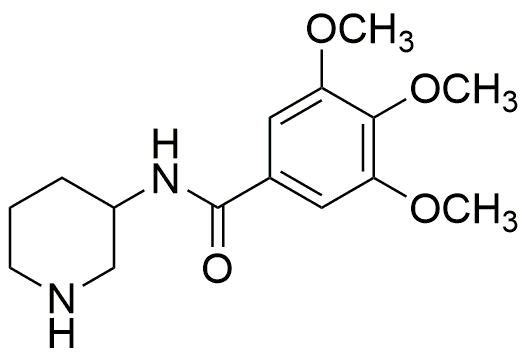Troxipide is widely utilized in research focused on:
- Gastrointestinal Health: Primarily used in the treatment of gastric disorders, it helps in reducing gastric acid secretion and promoting mucosal healing, making it beneficial for patients with ulcers.
- Pharmaceutical Development: Troxipide serves as a model compound in drug formulation studies, aiding researchers in understanding drug interactions and bioavailability in the gastrointestinal tract.
- Animal Health: Its application extends to veterinary medicine, where it is used to treat similar gastrointestinal issues in animals, ensuring better health management in livestock.
- Research on Mucosal Protection: The compound is studied for its protective effects on the gastric mucosa, providing insights into new therapeutic strategies for preventing gastric damage.
- Comparative Studies: Troxipide is often compared with other gastroprotective agents, offering researchers a unique perspective on efficacy and safety profiles in clinical settings.
Informations générales
Propriétés
Sécurité et réglementation
Applications
Troxipide is widely utilized in research focused on:
- Gastrointestinal Health: Primarily used in the treatment of gastric disorders, it helps in reducing gastric acid secretion and promoting mucosal healing, making it beneficial for patients with ulcers.
- Pharmaceutical Development: Troxipide serves as a model compound in drug formulation studies, aiding researchers in understanding drug interactions and bioavailability in the gastrointestinal tract.
- Animal Health: Its application extends to veterinary medicine, where it is used to treat similar gastrointestinal issues in animals, ensuring better health management in livestock.
- Research on Mucosal Protection: The compound is studied for its protective effects on the gastric mucosa, providing insights into new therapeutic strategies for preventing gastric damage.
- Comparative Studies: Troxipide is often compared with other gastroprotective agents, offering researchers a unique perspective on efficacy and safety profiles in clinical settings.
Documents
Fiches de données de sécurité (FDS)
La FDS fournit des informations de sécurité complètes sur la manipulation, le stockage et l’élimination du produit.
Spécifications du produit (PS)
Le PS fournit une description complète des propriétés du produit, notamment sa composition chimique, son état physique, sa pureté et les exigences de stockage. Il détaille également les plages de qualité acceptables et les applications prévues du produit.
Certificats d'analyse (COA)
Recherchez des certificats d'analyse (COA) en saisissant le numéro de lot du produit. Les numéros de lot et de lot se trouvent sur l'étiquette d'un produit, après les mots « Lot » ou « Lot de fabrication ».
Numéro de catalogue
Numéro de lot/série
Certificats d'origine (COO)
Ce certificat d'exploitation confirme le pays dans lequel le produit a été fabriqué, et détaille également les matériaux et composants utilisés et s'il est issu de sources naturelles, synthétiques ou autres sources spécifiques. Ce certificat peut être requis pour les douanes, le commerce et la conformité réglementaire.
Numéro de catalogue
Numéro de lot/série
Fiches de données de sécurité (FDS)
La FDS fournit des informations de sécurité complètes sur la manipulation, le stockage et l’élimination du produit.
DownloadSpécifications du produit (PS)
Le PS fournit une description complète des propriétés du produit, notamment sa composition chimique, son état physique, sa pureté et les exigences de stockage. Il détaille également les plages de qualité acceptables et les applications prévues du produit.
DownloadCertificats d'analyse (COA)
Recherchez des certificats d'analyse (COA) en saisissant le numéro de lot du produit. Les numéros de lot et de lot se trouvent sur l'étiquette d'un produit, après les mots « Lot » ou « Lot de fabrication ».
Numéro de catalogue
Numéro de lot/série
Certificats d'origine (COO)
Ce certificat d'exploitation confirme le pays dans lequel le produit a été fabriqué, et détaille également les matériaux et composants utilisés et s'il est issu de sources naturelles, synthétiques ou autres sources spécifiques. Ce certificat peut être requis pour les douanes, le commerce et la conformité réglementaire.


